| Listing 1 - 10 of 32 | << page >> |
Sort by
|
Book
Year: 2021 Publisher: Basel, Switzerland MDPI - Multidisciplinary Digital Publishing Institute
Abstract | Keywords | Export | Availability | Bookmark
 Loading...
Loading...Choose an application
- Reference Manager
- EndNote
- RefWorks (Direct export to RefWorks)
The issue "Mathematical Logic and Its Applications 2020" contains articles related to the following three directions: Descriptive Set Theory (3 articles). Solutions for long-standing problems, including those of A. Tarski and H. Friedman, are presented. Exact combinatorial optimization algorithms, in which the complexity relative to the source data is characterized by a low, or even first degree, polynomial (1 article). III. Applications of mathematical logic and the theory of algorithms (2 articles). The first article deals with the Jacobian and M. Kontsevich’s conjectures, and algorithmic undecidability; for these purposes, non-standard analysis is used. The second article provides a quantitative description of the balance and adaptive resource of a human. Submissions are invited for the next issue "Mathematical Logic and Its Applications 2021"
definability --- nonconstructible reals --- projective hierarchy --- generic models --- almost disjoint forcing --- Harvey Friedman’s problem --- almost-disjoint forcing --- universal algebraic geometry --- affine algebraic geometry --- elementary equivalence --- isotypic algebras --- first order rigidity --- Ind-group --- affine spaces --- automorphisms --- free associative algebras --- Weyl algebra automorphisms --- polynomial symplectomorphisms --- deformation quantization --- infinite prime number --- semi-inner automorphism --- embeddability of varieties --- undecidability --- noncommutative Gröbner-Shirshov basis --- finitely presented algebraic systems --- algorithmic unsolvability --- turing machine --- discrete optimization --- exact algorithm --- additively exact algorithm --- graph transformation --- graph of degree 2 --- chain-cycle graph --- operation cost --- minimization of total cost --- definability of definable --- tarski problem --- type theoretic hierarchy --- adaptive resource --- resilience --- resistance --- tipping point --- theory of catastrophes
Book
Year: 2021 Publisher: Basel, Switzerland MDPI - Multidisciplinary Digital Publishing Institute
Abstract | Keywords | Export | Availability | Bookmark
 Loading...
Loading...Choose an application
- Reference Manager
- EndNote
- RefWorks (Direct export to RefWorks)
Networks, communications, and computing have become ubiquitous and inseparable parts of everyday life. This book is based on a Special Issue of the Algorithms journal, and it is devoted to the exploration of the many-faceted relationship of networks, communications, and computing. The included papers explore the current state-of-the-art research in these areas, with a particular interest in the interactions among the fields.
communication traffic prediction --- intelligent traffic management --- deformable convolution --- attention mechanism --- the next generation of telecommunication (5G) --- deep learning --- reinforcement learning --- systematic review --- cellular networks --- underwater wireless sensor networks --- ant colony optimization algorithms --- clustering routing algorithms --- energy efficiency --- network lifetime --- unmanned aerial vehicles --- UAV placement --- metaheuristics --- routing --- NP-complete --- NP-hard --- approximation --- polynomial time algorithm --- disjoint connecting paths --- unsplittable flow --- network design
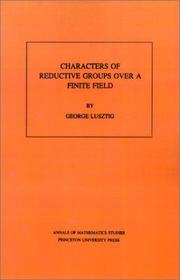
ISBN: 0691083509 0691083517 1400881773 9780691083513 9780691083506 Year: 2016 Volume: 107 Publisher: Princeton, NJ : Princeton University Press,
Abstract | Keywords | Export | Availability | Bookmark
 Loading...
Loading...Choose an application
- Reference Manager
- EndNote
- RefWorks (Direct export to RefWorks)
This book presents a classification of all (complex)irreducible representations of a reductive group withconnected centre, over a finite field. To achieve this,the author uses etale intersection cohomology, anddetailed information on representations of Weylgroups.
512 --- Characters of groups --- Finite fields (Algebra) --- Finite groups --- Groups, Finite --- Group theory --- Modules (Algebra) --- Modular fields (Algebra) --- Algebra, Abstract --- Algebraic fields --- Galois theory --- Characters, Group --- Group characters --- Groups, Characters of --- Representations of groups --- Rings (Algebra) --- Algebra --- 512 Algebra --- Finite groups. --- Characters of groups. --- Addition. --- Algebra representation. --- Algebraic closure. --- Algebraic group. --- Algebraic variety. --- Algebraically closed field. --- Bijection. --- Borel subgroup. --- Cartan subalgebra. --- Character table. --- Character theory. --- Characteristic function (probability theory). --- Characteristic polynomial. --- Class function (algebra). --- Classical group. --- Coefficient. --- Cohomology with compact support. --- Cohomology. --- Combination. --- Complex number. --- Computation. --- Conjugacy class. --- Connected component (graph theory). --- Coxeter group. --- Cyclic group. --- Cyclotomic polynomial. --- David Kazhdan. --- Dense set. --- Derived category. --- Diagram (category theory). --- Dimension. --- Direct sum. --- Disjoint sets. --- Disjoint union. --- E6 (mathematics). --- Eigenvalues and eigenvectors. --- Endomorphism. --- Equivalence class. --- Equivalence relation. --- Existential quantification. --- Explicit formula. --- Explicit formulae (L-function). --- Fiber bundle. --- Finite field. --- Finite group. --- Fourier transform. --- Green's function. --- Group (mathematics). --- Group action. --- Group representation. --- Harish-Chandra. --- Hecke algebra. --- Identity element. --- Integer. --- Irreducible representation. --- Isomorphism class. --- Jordan decomposition. --- Line bundle. --- Linear combination. --- Local system. --- Mathematical induction. --- Maximal torus. --- Module (mathematics). --- Monodromy. --- Morphism. --- Orthonormal basis. --- P-adic number. --- Parametrization. --- Parity (mathematics). --- Partially ordered set. --- Perverse sheaf. --- Pointwise. --- Polynomial. --- Quantity. --- Rational point. --- Reductive group. --- Ree group. --- Schubert variety. --- Scientific notation. --- Semisimple Lie algebra. --- Sheaf (mathematics). --- Simple group. --- Simple module. --- Special case. --- Standard basis. --- Subset. --- Subtraction. --- Summation. --- Surjective function. --- Symmetric group. --- Tensor product. --- Theorem. --- Two-dimensional space. --- Unipotent representation. --- Vector bundle. --- Vector space. --- Verma module. --- Weil conjecture. --- Weyl group. --- Zariski topology.
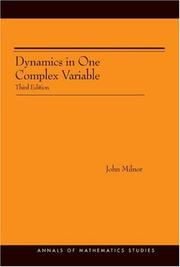
ISBN: 9780691124889 9780691124872 0691124884 0691124876 9786613001481 1400835534 1283001489 9781400835539 9781283001489 6613001481 Year: 2006 Publisher: Princeton, N.J. : Princeton University Press,
Abstract | Keywords | Export | Availability | Bookmark
 Loading...
Loading...Choose an application
- Reference Manager
- EndNote
- RefWorks (Direct export to RefWorks)
This volume studies the dynamics of iterated holomorphic mappings from a Riemann surface to itself, concentrating on the classical case of rational maps of the Riemann sphere. This subject is large and rapidly growing. These lectures are intended to introduce some key ideas in the field, and to form a basis for further study. The reader is assumed to be familiar with the rudiments of complex variable theory and of two-dimensional differential geometry, as well as some basic topics from topology. This third edition contains a number of minor additions and improvements: A historical survey has been added, the definition of Lattés map has been made more inclusive, and the écalle-Voronin theory of parabolic points is described. The résidu itératif is studied, and the material on two complex variables has been expanded. Recent results on effective computability have been added, and the references have been expanded and updated. Written in his usual brilliant style, the author makes difficult mathematics look easy. This book is a very accessible source for much of what has been accomplished in the field.
Functions of complex variables --- Holomorphic mappings --- Riemann surfaces --- Fonctions d'une variable complexe --- Applications holomorphes --- Riemann, surfaces de --- Holomorphic mappings. --- Mappings, Holomorphic --- Functions of complex variables. --- Riemann surfaces. --- Surfaces, Riemann --- Functions --- Functions of several complex variables --- Mappings (Mathematics) --- Complex variables --- Elliptic functions --- Functions of real variables --- Absolute value. --- Addition. --- Algebraic equation. --- Attractor. --- Automorphism. --- Beltrami equation. --- Blaschke product. --- Boundary (topology). --- Branched covering. --- Coefficient. --- Compact Riemann surface. --- Compact space. --- Complex analysis. --- Complex number. --- Complex plane. --- Computation. --- Connected component (graph theory). --- Connected space. --- Constant function. --- Continued fraction. --- Continuous function. --- Coordinate system. --- Corollary. --- Covering space. --- Cross-ratio. --- Derivative. --- Diagram (category theory). --- Diameter. --- Diffeomorphism. --- Differentiable manifold. --- Disjoint sets. --- Disjoint union. --- Disk (mathematics). --- Division by zero. --- Equation. --- Euler characteristic. --- Existential quantification. --- Exponential map (Lie theory). --- Fundamental group. --- Harmonic function. --- Holomorphic function. --- Homeomorphism. --- Hyperbolic geometry. --- Inequality (mathematics). --- Integer. --- Inverse function. --- Irrational rotation. --- Iteration. --- Jordan curve theorem. --- Julia set. --- Lebesgue measure. --- Lecture. --- Limit point. --- Line segment. --- Linear map. --- Linearization. --- Mandelbrot set. --- Mathematical analysis. --- Maximum modulus principle. --- Metric space. --- Monotonic function. --- Montel's theorem. --- Normal family. --- Open set. --- Orbifold. --- Parameter space. --- Parameter. --- Periodic point. --- Point at infinity. --- Polynomial. --- Power series. --- Proper map. --- Quadratic function. --- Rational approximation. --- Rational function. --- Rational number. --- Real number. --- Riemann sphere. --- Riemann surface. --- Root of unity. --- Rotation number. --- Schwarz lemma. --- Scientific notation. --- Sequence. --- Simply connected space. --- Special case. --- Subgroup. --- Subsequence. --- Subset. --- Summation. --- Tangent space. --- Theorem. --- Topological space. --- Topology. --- Uniform convergence. --- Uniformization theorem. --- Unit circle. --- Unit disk. --- Upper half-plane. --- Winding number.
Book
ISBN: 1282458582 9786612458583 1400831970 9781400831975 0691142483 9780691142487 0691142491 9780691142494 9781282458581 6612458585 Year: 2009 Publisher: Princeton, NJ : Princeton University Press,
Abstract | Keywords | Export | Availability | Bookmark
 Loading...
Loading...Choose an application
- Reference Manager
- EndNote
- RefWorks (Direct export to RefWorks)
Outer billiards is a basic dynamical system defined relative to a convex shape in the plane. B. H. Neumann introduced this system in the 1950's, and J. Moser popularized it as a toy model for celestial mechanics. All along, the so-called Moser-Neumann question has been one of the central problems in the field. This question asks whether or not one can have an outer billiards system with an unbounded orbit. The Moser-Neumann question is an idealized version of the question of whether, because of small disturbances in its orbit, the Earth can break out of its orbit and fly away from the Sun. In Outer Billiards on Kites, Richard Schwartz presents his affirmative solution to the Moser-Neumann problem. He shows that an outer billiards system can have an unbounded orbit when defined relative to any irrational kite. A kite is a quadrilateral having a diagonal that is a line of bilateral symmetry. The kite is irrational if the other diagonal divides the quadrilateral into two triangles whose areas are not rationally related. In addition to solving the basic problem, Schwartz relates outer billiards on kites to such topics as Diophantine approximation, the modular group, self-similar sets, polytope exchange maps, profinite completions of the integers, and solenoids--connections that together allow for a fairly complete analysis of the dynamical system.
Hyperbolic spaces. --- Singularities (Mathematics) --- Transformations (Mathematics) --- Geometry, Plane. --- Plane geometry --- Algorithms --- Differential invariants --- Geometry, Differential --- Geometry, Algebraic --- Hyperbolic complex manifolds --- Manifolds, Hyperbolic complex --- Spaces, Hyperbolic --- Geometry, Non-Euclidean --- Abelian group. --- Automorphism. --- Big O notation. --- Bijection. --- Binary number. --- Bisection. --- Borel set. --- C0. --- Calculation. --- Cantor set. --- Cartesian coordinate system. --- Combination. --- Compass-and-straightedge construction. --- Congruence subgroup. --- Conjecture. --- Conjugacy class. --- Continuity equation. --- Convex lattice polytope. --- Convex polytope. --- Coprime integers. --- Counterexample. --- Cyclic group. --- Diameter. --- Diophantine approximation. --- Diophantine equation. --- Disjoint sets. --- Disjoint union. --- Division by zero. --- Embedding. --- Equation. --- Equivalence class. --- Ergodic theory. --- Ergodicity. --- Factorial. --- Fiber bundle. --- Fibonacci number. --- Fundamental domain. --- Gauss map. --- Geometry. --- Half-integer. --- Homeomorphism. --- Hyperbolic geometry. --- Hyperplane. --- Ideal triangle. --- Intersection (set theory). --- Interval exchange transformation. --- Inverse function. --- Inverse limit. --- Isometry group. --- Lattice (group). --- Limit set. --- Line segment. --- Linear algebra. --- Linear function. --- Line–line intersection. --- Main diagonal. --- Modular group. --- Monotonic function. --- Multiple (mathematics). --- Orthant. --- Outer billiard. --- Parallelogram. --- Parameter. --- Partial derivative. --- Penrose tiling. --- Permutation. --- Piecewise. --- Polygon. --- Polyhedron. --- Polytope. --- Product topology. --- Projective geometry. --- Rectangle. --- Renormalization. --- Rhombus. --- Right angle. --- Rotational symmetry. --- Sanity check. --- Scientific notation. --- Semicircle. --- Sign (mathematics). --- Special case. --- Square root of 2. --- Subsequence. --- Summation. --- Symbolic dynamics. --- Symmetry group. --- Tangent. --- Tetrahedron. --- Theorem. --- Toy model. --- Translational symmetry. --- Trapezoid. --- Triangle group. --- Triangle inequality. --- Two-dimensional space. --- Upper and lower bounds. --- Upper half-plane. --- Without loss of generality. --- Yair Minsky.

ISBN: 0691002576 1400865182 9781400865185 9780691002583 9780691002576 0691002584 9780691002583 Year: 1998 Publisher: Princeton, New Jersey : Princeton University Press,
Abstract | Keywords | Export | Availability | Bookmark
 Loading...
Loading...Choose an application
- Reference Manager
- EndNote
- RefWorks (Direct export to RefWorks)
In 1920, Pierre Fatou expressed the conjecture that--except for special cases--all critical points of a rational map of the Riemann sphere tend to periodic orbits under iteration. This conjecture remains the main open problem in the dynamics of iterated maps. For the logistic family x- ax(1-x), it can be interpreted to mean that for a dense set of parameters "a," an attracting periodic orbit exists. The same question appears naturally in science, where the logistic family is used to construct models in physics, ecology, and economics. In this book, Jacek Graczyk and Grzegorz Swiatek provide a rigorous proof of the Real Fatou Conjecture. In spite of the apparently elementary nature of the problem, its solution requires advanced tools of complex analysis. The authors have written a self-contained and complete version of the argument, accessible to someone with no knowledge of complex dynamics and only basic familiarity with interval maps. The book will thus be useful to specialists in real dynamics as well as to graduate students.
Geodesics (Mathematics) --- Polynomials. --- Mappings (Mathematics) --- Maps (Mathematics) --- Functions --- Functions, Continuous --- Topology --- Transformations (Mathematics) --- Algebra --- Geometry, Differential --- Global analysis (Mathematics) --- Mathematics --- Absolute value. --- Affine transformation. --- Algebraic function. --- Analytic continuation. --- Analytic function. --- Arithmetic. --- Automorphism. --- Big O notation. --- Bounded set (topological vector space). --- C0. --- Calculation. --- Canonical map. --- Change of variables. --- Chebyshev polynomials. --- Combinatorics. --- Commutative property. --- Complex number. --- Complex plane. --- Complex quadratic polynomial. --- Conformal map. --- Conjecture. --- Conjugacy class. --- Conjugate points. --- Connected component (graph theory). --- Connected space. --- Continuous function. --- Corollary. --- Covering space. --- Critical point (mathematics). --- Dense set. --- Derivative. --- Diffeomorphism. --- Dimension. --- Disjoint sets. --- Disjoint union. --- Disk (mathematics). --- Equicontinuity. --- Estimation. --- Existential quantification. --- Fibonacci. --- Functional equation. --- Fundamental domain. --- Generalization. --- Great-circle distance. --- Hausdorff distance. --- Holomorphic function. --- Homeomorphism. --- Homotopy. --- Hyperbolic function. --- Imaginary number. --- Implicit function theorem. --- Injective function. --- Integer. --- Intermediate value theorem. --- Interval (mathematics). --- Inverse function. --- Irreducible polynomial. --- Iteration. --- Jordan curve theorem. --- Julia set. --- Limit of a sequence. --- Linear map. --- Local diffeomorphism. --- Mathematical induction. --- Mathematical proof. --- Maxima and minima. --- Meromorphic function. --- Moduli (physics). --- Monomial. --- Monotonic function. --- Natural number. --- Neighbourhood (mathematics). --- Open set. --- Parameter. --- Periodic function. --- Periodic point. --- Phase space. --- Point at infinity. --- Polynomial. --- Projection (mathematics). --- Quadratic function. --- Quadratic. --- Quasiconformal mapping. --- Renormalization. --- Riemann sphere. --- Riemann surface. --- Schwarzian derivative. --- Scientific notation. --- Subsequence. --- Theorem. --- Theory. --- Topological conjugacy. --- Topological entropy. --- Topology. --- Union (set theory). --- Unit circle. --- Unit disk. --- Upper and lower bounds. --- Upper half-plane. --- Z0.
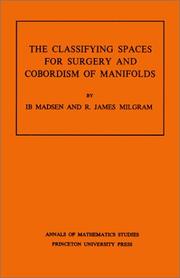
ISBN: 0691082251 069108226X 1400881471 Year: 1979 Publisher: Princeton : Tokyo : Princeton University Press Tokyo university press,
Abstract | Keywords | Export | Availability | Bookmark
 Loading...
Loading...Choose an application
- Reference Manager
- EndNote
- RefWorks (Direct export to RefWorks)
Beginning with a general discussion of bordism, Professors Madsen and Milgram present the homotopy theory of the surgery classifying spaces and the classifying spaces for the various required bundle theories. The next part covers more recent work on the maps between these spaces and the properties of the PL and Top characteristic classes, and includes integrality theorems for topological and PL manifolds. Later chapters treat the integral cohomology of BPL and Btop. The authors conclude with a discussion of the PL and topological cobordism rings and a construction of the torsion-free generators.
Algebraic topology --- 515.16 --- Classifying spaces --- Cobordism theory --- Manifolds (Mathematics) --- Surgery (Topology) --- Differential topology --- Homotopy equivalences --- Topology --- Geometry, Differential --- Spaces, Classifying --- Fiber bundles (Mathematics) --- Fiber spaces (Mathematics) --- Topology of manifolds --- Classifying spaces. --- Cobordism theory. --- Manifolds (Mathematics). --- Surgery (Topology). --- 515.16 Topology of manifolds --- Bijection. --- Calculation. --- Characteristic class. --- Classification theorem. --- Classifying space. --- Closed manifold. --- Cobordism. --- Coefficient. --- Cohomology. --- Commutative diagram. --- Commutative property. --- Complex projective space. --- Connected sum. --- Corollary. --- Cup product. --- Diagram (category theory). --- Differentiable manifold. --- Disjoint union. --- Disk (mathematics). --- Effective method. --- Eilenberg–Moore spectral sequence. --- Elaboration. --- Equivalence class. --- Exact sequence. --- Exterior algebra. --- Fiber bundle. --- Fibration. --- Function composition. --- H-space. --- Homeomorphism. --- Homomorphism. --- Homotopy fiber. --- Homotopy group. --- Homotopy. --- Hopf algebra. --- Iterative method. --- Loop space. --- Manifold. --- Massey product. --- N-sphere. --- Normal bundle. --- Obstruction theory. --- Pairing. --- Permutation. --- Piecewise linear manifold. --- Piecewise linear. --- Polynomial. --- Prime number. --- Projective space. --- Sequence. --- Simply connected space. --- Special case. --- Spin structure. --- Steenrod algebra. --- Subset. --- Summation. --- Tensor product. --- Theorem. --- Topological group. --- Topological manifold. --- Topology. --- Total order. --- Variétés topologiques --- Topologie differentielle
Book
ISBN: 0691615004 0691642575 1400856450 9781400856459 0691082901 9780691082905 9780691615004 9780691615004 9780691642574 Year: 2014 Publisher: Princeton, NJ : Princeton University Press,
Abstract | Keywords | Export | Availability | Bookmark
 Loading...
Loading...Choose an application
- Reference Manager
- EndNote
- RefWorks (Direct export to RefWorks)
Mathematical No/ex, 27Originally published in 1981.The Princeton Legacy Library uses the latest print-on-demand technology to again make available previously out-of-print books from the distinguished backlist of Princeton University Press. These editions preserve the original texts of these important books while presenting them in durable paperback and hardcover editions. The goal of the Princeton Legacy Library is to vastly increase access to the rich scholarly heritage found in the thousands of books published by Princeton University Press since its founding in 1905.
Riemannian manifolds. --- Minimal surfaces. --- Surfaces, Minimal --- Maxima and minima --- Manifolds, Riemannian --- Riemannian space --- Space, Riemannian --- Geometry, Differential --- Manifolds (Mathematics) --- Differential geometry. Global analysis --- Addition. --- Analytic function. --- Branch point. --- Calculation. --- Cartesian coordinate system. --- Closed geodesic. --- Codimension. --- Coefficient. --- Compactness theorem. --- Compass-and-straightedge construction. --- Continuous function. --- Corollary. --- Counterexample. --- Covering space. --- Curvature. --- Curve. --- Decomposition theorem. --- Derivative. --- Differentiable manifold. --- Differential geometry. --- Disjoint union. --- Equation. --- Essential singularity. --- Estimation. --- Euclidean space. --- Existence theorem. --- Existential quantification. --- First variation. --- Flat topology. --- Fundamental group. --- Geometric measure theory. --- Great circle. --- Homology (mathematics). --- Homotopy group. --- Homotopy. --- Hyperbolic function. --- Hypersurface. --- Integer. --- Line–line intersection. --- Manifold. --- Measure (mathematics). --- Minimal surface. --- Monograph. --- Natural number. --- Open set. --- Parameter. --- Partition of unity. --- Pointwise. --- Quantity. --- Regularity theorem. --- Riemann surface. --- Riemannian manifold. --- Scalar curvature. --- Scientific notation. --- Second fundamental form. --- Sectional curvature. --- Sequence. --- Sign (mathematics). --- Simply connected space. --- Smoothness. --- Sobolev inequality. --- Solid torus. --- Subgroup. --- Submanifold. --- Summation. --- Theorem. --- Topology. --- Two-dimensional space. --- Unit sphere. --- Upper and lower bounds. --- Varifold. --- Weak topology.
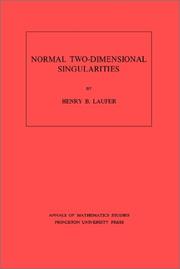
ISBN: 069108100X 1400881749 9780691081007 Year: 1971 Volume: 71 Publisher: Princeton : Princeton University Press,
Abstract | Keywords | Export | Availability | Bookmark
 Loading...
Loading...Choose an application
- Reference Manager
- EndNote
- RefWorks (Direct export to RefWorks)
A survey, thorough and timely, of the singularities of two-dimensional normal complex analytic varieties, the volume summarizes the results obtained since Hirzebruch's thesis (1953) and presents new contributions. First, the singularity is resolved and shown to be classified by its resolution; then, resolutions are classed by the use of spaces with nilpotents; finally, the spaces with nilpotents are determined by means of the local ring structure of the singularity.
Algebraic geometry --- Analytic spaces --- SINGULARITIES (Mathematics) --- 512.76 --- Singularities (Mathematics) --- Geometry, Algebraic --- Spaces, Analytic --- Analytic functions --- Functions of several complex variables --- Birational geometry. Mappings etc. --- Analytic spaces. --- Singularities (Mathematics). --- 512.76 Birational geometry. Mappings etc. --- Birational geometry. Mappings etc --- Analytic function. --- Analytic set. --- Analytic space. --- Automorphism. --- Bernhard Riemann. --- Big O notation. --- Calculation. --- Chern class. --- Codimension. --- Coefficient. --- Cohomology. --- Compact Riemann surface. --- Complex manifold. --- Computation. --- Connected component (graph theory). --- Continuous function. --- Contradiction. --- Coordinate system. --- Corollary. --- Covering space. --- Dimension. --- Disjoint union. --- Divisor. --- Dual graph. --- Elliptic curve. --- Elliptic function. --- Embedding. --- Existential quantification. --- Factorization. --- Fiber bundle. --- Finite set. --- Formal power series. --- Hausdorff space. --- Holomorphic function. --- Homeomorphism. --- Homology (mathematics). --- Intersection (set theory). --- Intersection number (graph theory). --- Inverse limit. --- Irreducible component. --- Isolated singularity. --- Iteration. --- Lattice (group). --- Line bundle. --- Linear combination. --- Line–line intersection. --- Local coordinates. --- Local ring. --- Mathematical induction. --- Maximal ideal. --- Meromorphic function. --- Monic polynomial. --- Nilpotent. --- Normal bundle. --- Open set. --- Parameter. --- Plane curve. --- Pole (complex analysis). --- Power series. --- Presheaf (category theory). --- Projective line. --- Quadratic transformation. --- Quantity. --- Riemann surface. --- Riemann–Roch theorem. --- Several complex variables. --- Submanifold. --- Subset. --- Tangent bundle. --- Tangent space. --- Tensor algebra. --- Theorem. --- Topological space. --- Transition function. --- Two-dimensional space. --- Variable (mathematics). --- Zero divisor. --- Zero of a function. --- Zero set. --- Variétés complexes --- Espaces analytiques
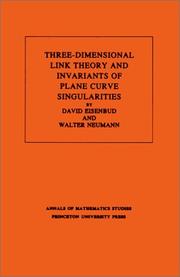
ISBN: 0691083819 0691083800 1400881927 9780691083810 9780691083803 Year: 1985 Volume: 110 Publisher: Princeton Princeton University Press
Abstract | Keywords | Export | Availability | Bookmark
 Loading...
Loading...Choose an application
- Reference Manager
- EndNote
- RefWorks (Direct export to RefWorks)
This book gives a new foundation for the theory of links in 3-space modeled on the modern developmentby Jaco, Shalen, Johannson, Thurston et al. of the theory of 3-manifolds. The basic construction is a method of obtaining any link by "splicing" links of the simplest kinds, namely those whose exteriors are Seifert fibered or hyperbolic. This approach to link theory is particularly attractive since most invariants of links are additive under splicing.Specially distinguished from this viewpoint is the class of links, none of whose splice components is hyperbolic. It includes all links constructed by cabling and connected sums, in particular all links of singularities of complex plane curves. One of the main contributions of this monograph is the calculation of invariants of these classes of links, such as the Alexander polynomials, monodromy, and Seifert forms.
Algebraic geometry --- Differential geometry. Global analysis --- Link theory. --- Curves, Plane. --- SINGULARITIES (Mathematics) --- Curves, Plane --- Invariants --- Link theory --- Singularities (Mathematics) --- Geometry, Algebraic --- Low-dimensional topology --- Piecewise linear topology --- Higher plane curves --- Plane curves --- Invariants. --- 3-sphere. --- Alexander Grothendieck. --- Alexander polynomial. --- Algebraic curve. --- Algebraic equation. --- Algebraic geometry. --- Algebraic surface. --- Algorithm. --- Ambient space. --- Analytic function. --- Approximation. --- Big O notation. --- Call graph. --- Cartesian coordinate system. --- Characteristic polynomial. --- Closed-form expression. --- Cohomology. --- Computation. --- Conjecture. --- Connected sum. --- Contradiction. --- Coprime integers. --- Corollary. --- Curve. --- Cyclic group. --- Determinant. --- Diagram (category theory). --- Diffeomorphism. --- Dimension. --- Disjoint union. --- Eigenvalues and eigenvectors. --- Equation. --- Equivalence class. --- Euler number. --- Existential quantification. --- Exterior (topology). --- Fiber bundle. --- Fibration. --- Foliation. --- Fundamental group. --- Geometry. --- Graph (discrete mathematics). --- Ground field. --- Homeomorphism. --- Homology sphere. --- Identity matrix. --- Integer matrix. --- Intersection form (4-manifold). --- Isolated point. --- Isolated singularity. --- Jordan normal form. --- Knot theory. --- Mathematical induction. --- Monodromy matrix. --- Monodromy. --- N-sphere. --- Natural transformation. --- Newton polygon. --- Newton's method. --- Normal (geometry). --- Notation. --- Pairwise. --- Parametrization. --- Plane curve. --- Polynomial. --- Power series. --- Projective plane. --- Puiseux series. --- Quantity. --- Rational function. --- Resolution of singularities. --- Riemann sphere. --- Riemann surface. --- Root of unity. --- Scientific notation. --- Seifert surface. --- Set (mathematics). --- Sign (mathematics). --- Solid torus. --- Special case. --- Stereographic projection. --- Submanifold. --- Summation. --- Theorem. --- Three-dimensional space (mathematics). --- Topology. --- Torus knot. --- Torus. --- Tubular neighborhood. --- Unit circle. --- Unit vector. --- Unknot. --- Variable (mathematics).
| Listing 1 - 10 of 32 | << page >> |
Sort by
|

 Search
Search Feedback
Feedback About
About Help
Help News
News